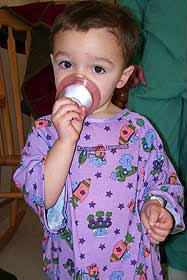What is an anesthesiologist?
Anesthesiologists are doctors who specialize in providing medication that causes patients to become drowsy or fall asleep (often referred to as sedation). Sedation allows patients to go through procedures that would otherwise be too stressful or painful to undergo without receiving medication.
Anesthesiologists are experts at knowing which medications best match the type of surgery your child is having. Anesthesiologists are also experts at maintaining safety and managing any type of emergency that may arise during a procedure.
How can medication be given?
Every child is different, and each child has different needs if he or she is to have a comfortable experience during a test or procedure.
Anesthesiologists have many types of medication they can use and can give medication in many ways, including:
- By mouth
- By breathing it in through a mask
- Through an IV (intravenous, in a vein)
- With an injection
Most children under the age of 13 years are able to use a mask to get anesthesia. Most children 13 years and older require an IV. Most of the time numbing medication can be used so that your child does not feel the needle poke when getting the IV. You and your child's anesthesiologist will work together to create the safest and best plan for your child.
The way medication can be given depends upon the specific medication being used, and the specific requirements for completion of the test or procedure.
Developing a sedation plan for your child
The Child Life Specialist, the nurse, and the anesthesiologist develop a plan based on your child's support needs. The plan will ensure your child has a comfortable experience and will be exposed to the least amount of stress possible. This plan may involve distraction and support by the Child Life Specialist, sedation by the anesthesiologist, anesthesia by an anesthesiologist, or a combination of all of these.
How do I explain what anesthesia (an-es-thee-zee-uh) is to my child?
"Anesthesia is medicine that helps you sleep during surgery, so that you do not see, hear, or feel the surgery."
How do I explain the IV to my child?
"An IV is a tiny plastic straw that goes in your hand or your arm and allows your body to 'drink' the medicine. In order for the straw to get into the right place, there is a small poke with a needle."
What can I expect to see as my child goes off to sleep with anesthesia?
Every sedation/anesthesia experience is a little different. As children become sleepy from anesthesia, some simply close their eyes and fall asleep smoothly, while others enter a stage of excitement before drifting off to sleep.
During the "excitement stage," children are already asleep enough that they do not have control of their movements and don't remember this phase. Children may move their arms or legs. Their movements can range from gentle to more forceful, and some appear "seizure-like." Some appear dizzy, breathe noisily, or cough. You may also see unusual eye movements such as eye rolling. This may be upsetting to see, but be assured that this is all very normal during this stage of anesthesia.
Your child will become limp as he or she relaxes into a very deep sleep. Once your child is asleep, you may kiss or gently touch your child before you are escorted to the same-day waiting area.
How will my child awaken from anesthesia?
Everyone's experience is a little different. In general, children tolerate anesthesia and sedation very well. Some children will wake quickly and may be awake before their families arrive to see them. Other children may remain sleeping for several minutes or hours from the effects of the anesthesia.
Some children may thrash, cry, seem inconsolable, or have difficulty recognizing familiar objects or people. This behavior is not usually related to pain and typically children do not remember it. This wake up is known as "emergence delirium" and will pass with time.
Please do not wake your child. In our experience, children often have a gentler and more comfortable wake up when they wake on their own.
How will my child be after sedation/anesthesia?
It is rare that children vomit afterwards, although it does happen on occasion. With certain procedures (such as tonsillectomies) it is relatively common.
Children will not have their usual balance and coordination after sedation/anesthesia. Although young children may be persistent in wanting to walk on their own, it is unsafe for them to do so for several hours after their procedure.
You should avoid having your child do anything that may require coordination or quick response during the rest of the day after receiving sedation/anesthesia. Please have your child avoid activities such as:
- Walking up or down stairs
- Riding a bike/skateboard/ATV
- Swimming
- Using playground equipment
